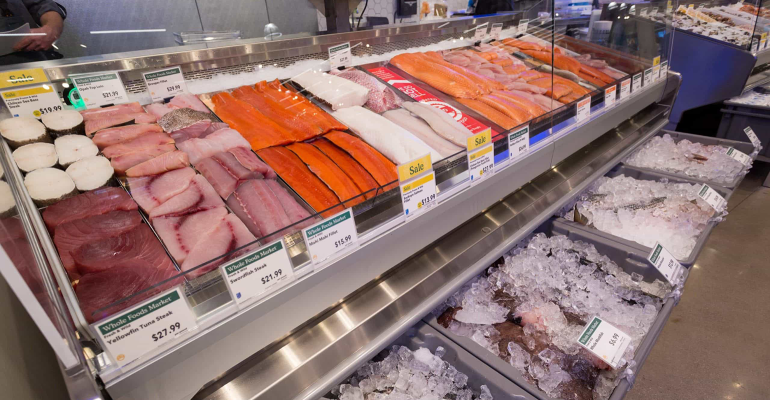When it comes to the in-store merchandising of fresh seafood, less might be more.
While offering expansive arrays of fresh seafood may enable supermarkets to attract some additional shoppers, the measures also are likely to result in greater waste, higher labor expenses, and less visually appealing selections, according to Joseph Sabbagh, president of Sax Maritime Associates, a Calabasas, Calif.-based seafood consulting company.
Instead, he recommends that retailers just offer a small variety of the most popular fresh items while expanding frozen offerings. The best-selling fresh selections include salmon, crab, shrimp, lobster, and catfish, reports Circana, a Chicago-based market research firm. Shrimp, salmon, pollock, tilapia, and crab are the top-selling frozen species.
“Most fresh seafood counters have plenty of space,” Sabbagh said. “They are just selling way too many items.”
Merchandising fresh seafood is extremely labor intensive and costly, he said, citing the need to stock displays with fresh ice each day to hold recently thawed seafood and give the appearance of freshness, while maintaining a clean environment. Reducing the amounts of thawed products also will result in lower utility and worker expenses, Sabbagh said, adding that thawed seafood is also typically less attractive than other products.
“Retailers have to think outside the fresh case by reducing the square footage that is used to sell thawed products and improve merchandising in the frozen departments,” he said. “Rather than have a 12- to 16-foot case in the seafood department, decrease it to just six or eight feet of fresh fish.”
Operators can create more space for frozen seafood by situating additional coffin cases in aisles, Sabbagh said.
Merchandising selections in other store departments will expand seafood’s reach as well, he said. That includes situating fresh value-added selections in the deli, such as cooked shrimp and crab legs, he said.
Such measures will enable retailers to spotlight seafood to greater amounts of shoppers while reducing the threat of cross contamination by eliminating the merchandising of both raw and cooked seafood in the same case, Sabbagh said.
“There is no cooked meat in the supermarket meat department, but seafood departments may offer cooked shrimp and have the same associate handling both the cooked and raw products,” he said. “It makes no sense.”
Restricting displays to the most popular fresh seafood is also crucial for avoiding spoilage, he said. While there are hundreds of species of edible seafood, most consumers are only familiar with a small number, which makes merchandising additional varieties “a crap shoot, especially if they are expensive,” Sabbagh said.
“There are a limited number of people who will buy unfamiliar selections,” he said. “Stores can lose a lot of money by bringing in extremely expensive whitefish that they may have to throw out. Seafood is insignificant to most people.”
Sabbagh said the most pertinent species to carry will vary by outlet in accordance with such shopper demographic factors as ethnicity and income level. “It is tough to get a one size fits all,” he said. “Retailers have to crunch their numbers and look at the financial value of seafood to the store and the ambiance that it might create.”
Demand for specific products will also differ by region, Sabbagh said. For instance, while Dungeness crab is “huge” in San Francisco and can be found in most groceries, only a relative handful of outlets, and mostly Asian-oriented stores, will merchandise the item in Southern California, he said.
In addition, “head-on shrimp sells well in Dallas but will just sit in Houston,” Sabbagh said.
Along with expanding the merchandising of frozen and prepared deli seafood offerings, retailers can also increase activity by offering larger arrays of ambient products beyond canned tuna and salmon, he said. That can include selling full-meal solutions, items in pouches, and soups, chowders, and curries that contain seafood, Sabbagh said.
“Ambient seafood has a lower footprint than anything else and has held up well over the last several years so why not expand on that?” he said. “It is sustainable, less expensive, cheap to merchandise and move around, and not labor intensive.”
The attention and importance that supermarket operators place on seafood, however, will ultimately depend on its perceived profitability, Sabbagh said. “Back in the days, and especially the mid-1980s, retailers could throw anything out and people would pay for it as long as it was fish,” Sabbagh said`. “Now it’s a big battle.”





